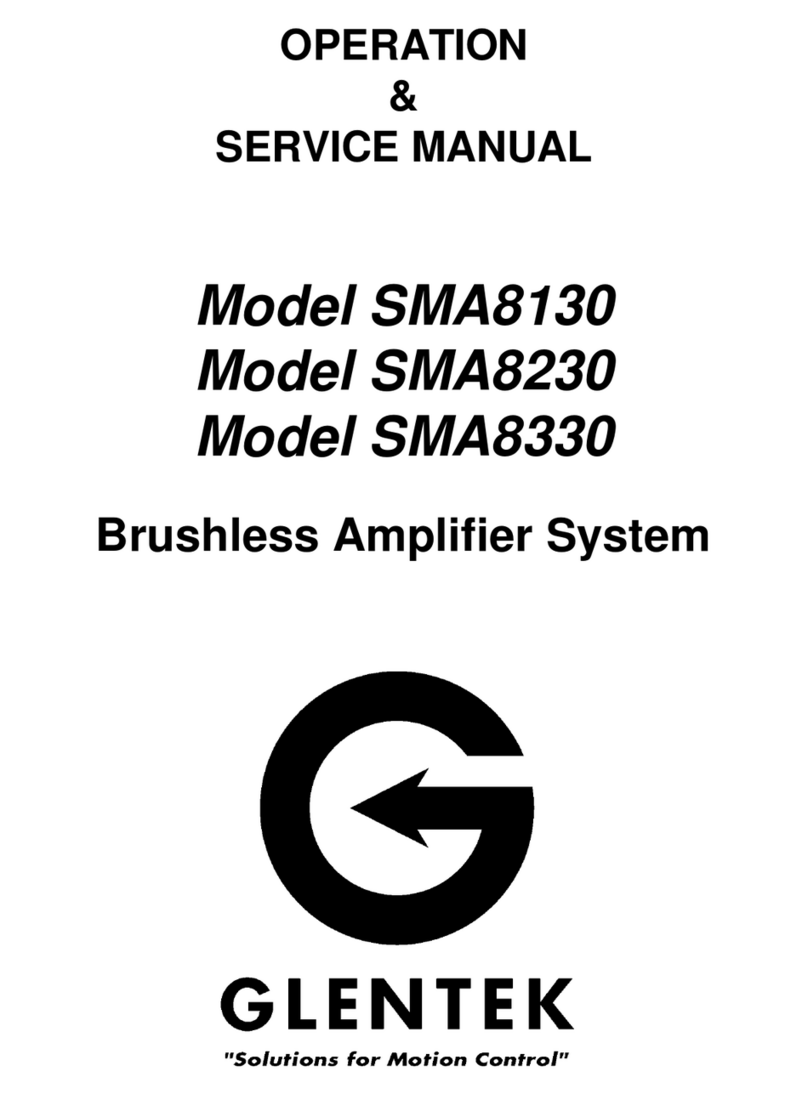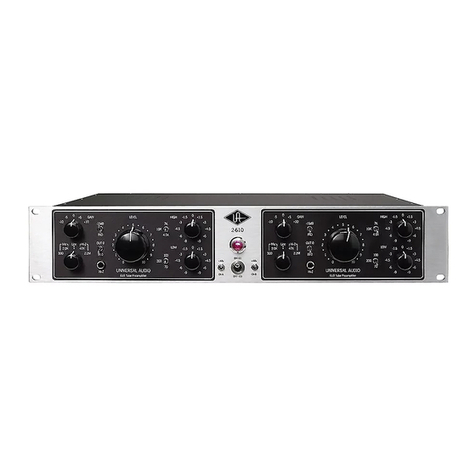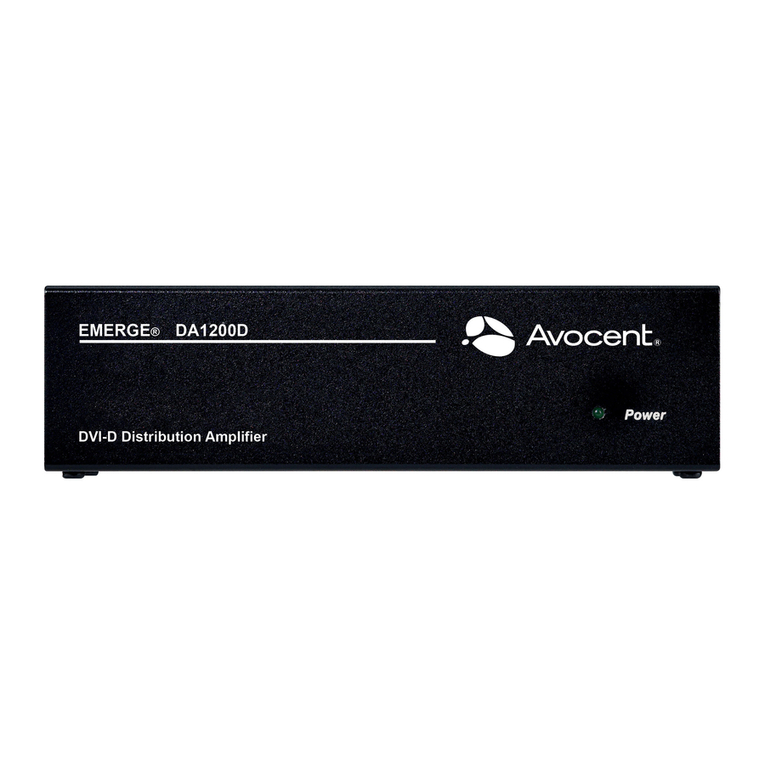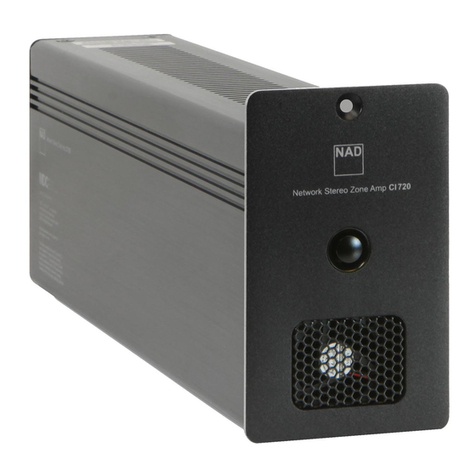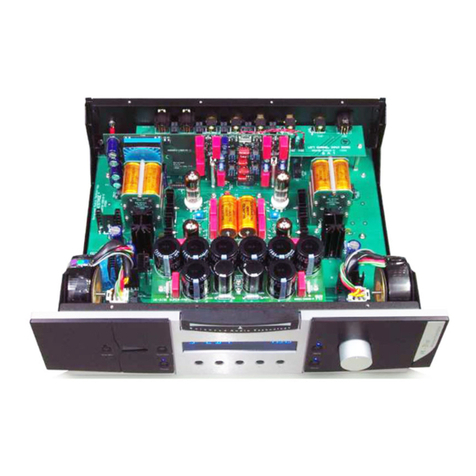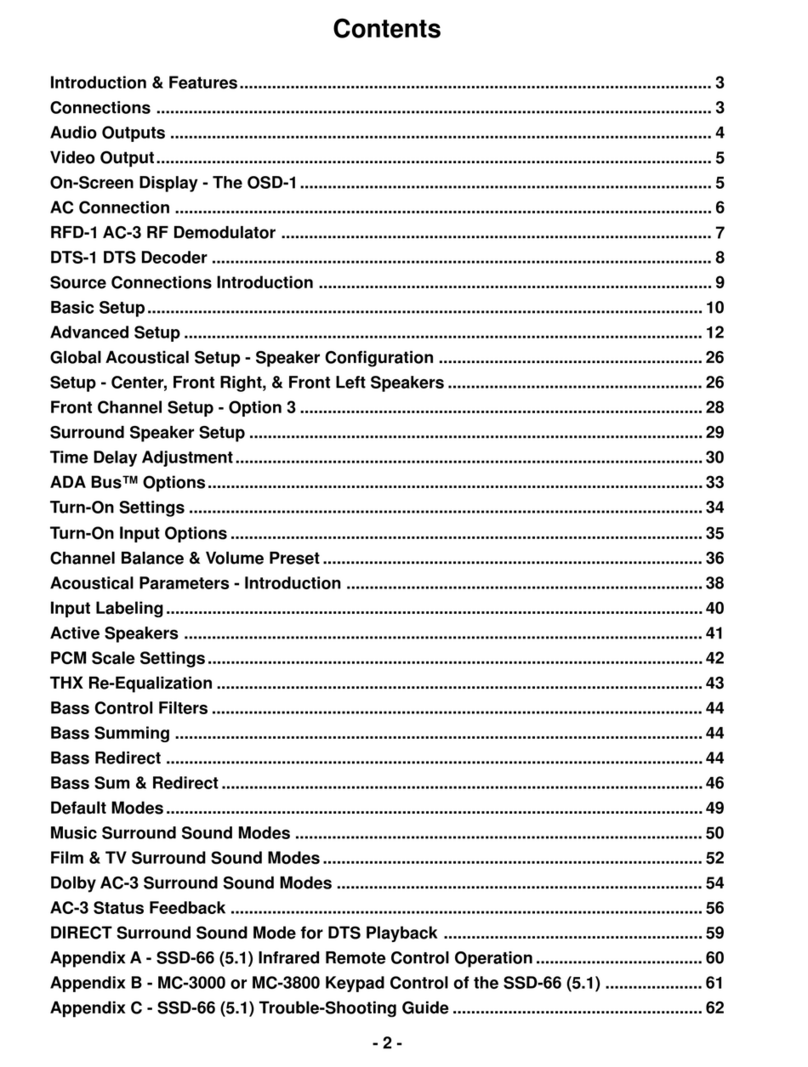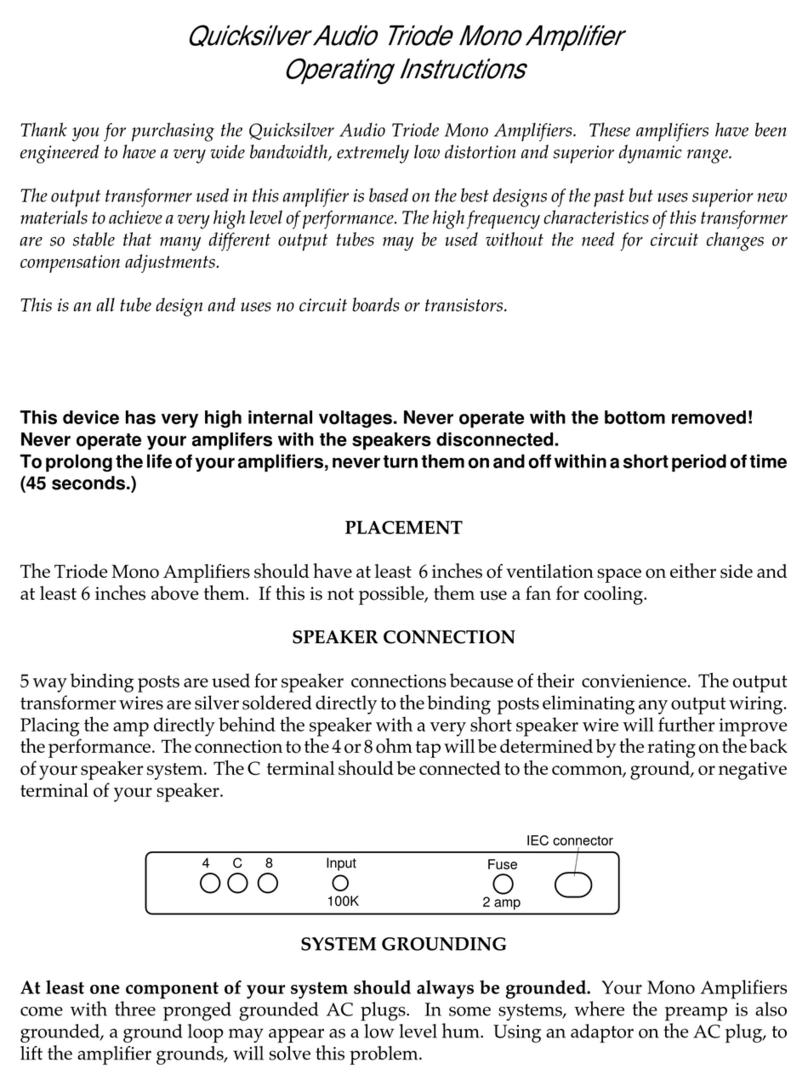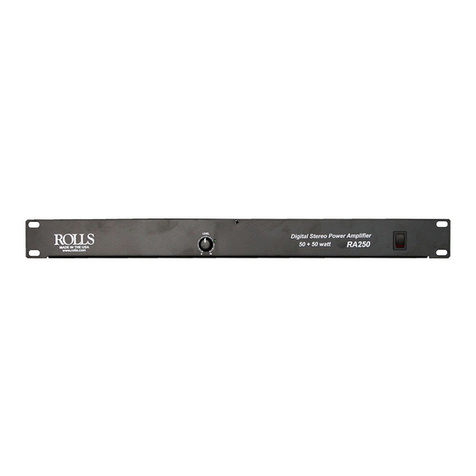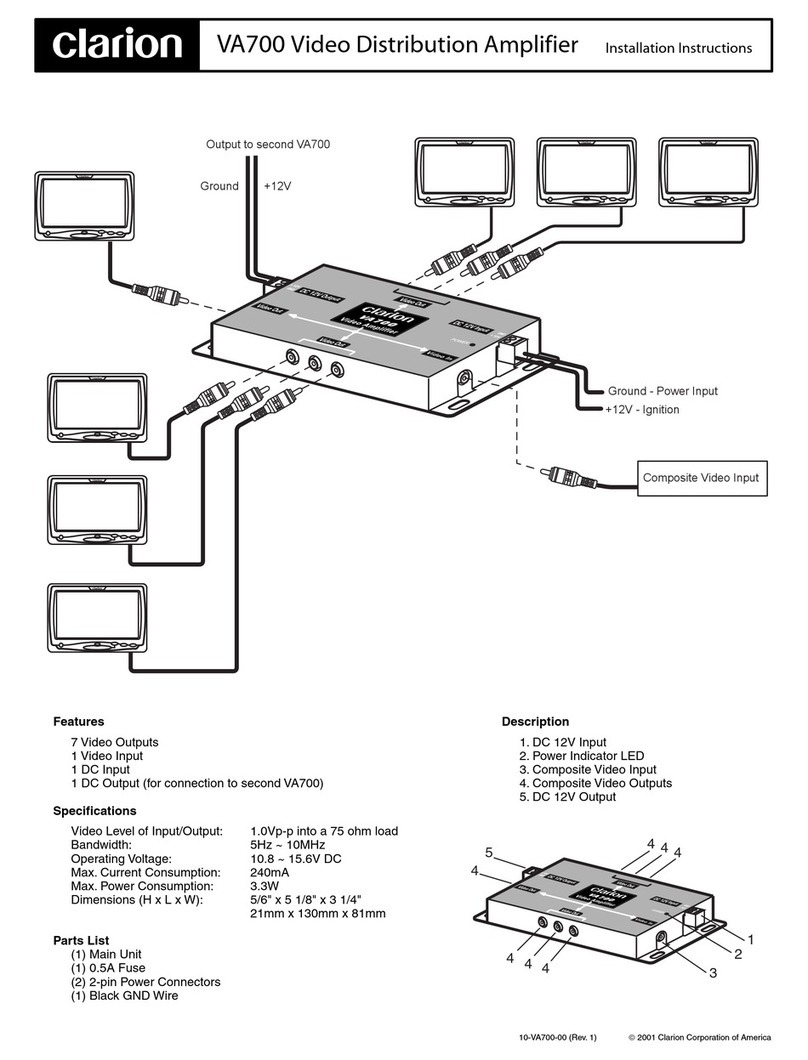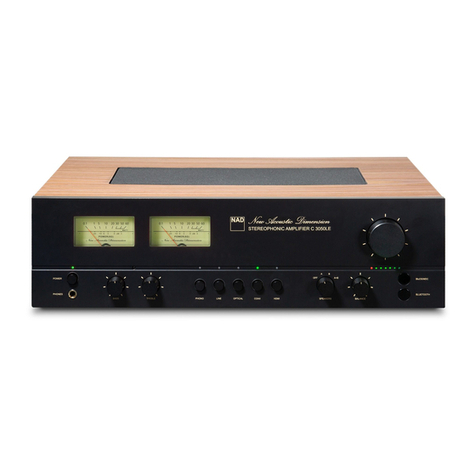Glentek GA4571PR2 Installation and operating instructions

OPERATION
&
SERVICE MANUAL
Model GA4571PR2
Model GA4576PR2
Model GA4581PR2
Model GA4582PR2
Pulse Width Modulated
Servo Amplifier


GLENTEK Inc. 208 Standard Street, El Segundo, California 90245, U.S.A. (310) 322
-
3026
3
OPERATION AND SERVICE MANUAL
FOR MODEL GA45 -71PR2 -76PR2 -81PR2 -82PR2
TABLE OF CONTENTS
PAGE
CHAPTER ONE: INTRODUCTION
1.1 INTRODUCTION TO THE GA45xxPR2 MANUAL................................................................. 7
CHAPTER TWO: DESCRIPTION AND SPECIFICATIONS
2.1 DESCRIPTION OF THE GA45xxPR2.................................................................................... 8
2.2 MODEL NUMBERING INFORMATION AND AVAILABLE OPTIONS................................... 8
2.2.1 MODEL NUMBERING............................................................................................... 8
2.2.2 VELOCITY-MODE OR CURRENT-MODE OPTIONS.............................................. 9
2.2.3 “LOGIC” INPUTS........................................................................................................ 9
2.3 PROTECTION CIRCUITS....................................................................................................... 9
2.3.1 OVER-TEMP INDICATOR OPERATION (RED LED)................................................ 9
2.3.2 DRIVE INHIBIT INDICATOR (RED LED) AND FAULT RELAY OPERATION .......... 9
2.3.3 TACH-LOSS INDICATOR (RED LED) AND RELAY OPERATION........................... 10
2.3.4 HIGH-SPEED ELECTRONIC CIRCUIT BREAKER (RED LED)................................ 10
2.3.5 POWER-SUPPLY MONITOR .................................................................................... 10
2.3.6 LOW-SPEED ELECTRONIC CIRCUIT BREAKER (RED LED).................................. 10
2.3.7 DC BUS VOLTAGE REGEN’ CLAMP & RESISTOR.................................................. 10
2.4 SPECIFICATIONS.................................................................................................................... 11
2.4.1 OUTPUT POWER....................................................................................................... 11
2.4.2 INPUT POWER ......................................................................................................... 11
2.4.3 SIGNAL INPUTS....................................................................................................... 11
2.4.4 OTHER INPUTS AND OUTPUTS............................................................................. 11
2.4.5 OTHER SPECIFICATIONS....................................................................................... 12
2.4.6 MECHANICAL (ALSO SEE APPENDIX B4-B6) ....................................................... 12
2.4.7 TYPICAL FACTORY SETTINGS.............................................................................. 12

GLENTEK Inc. 208 Standard Street, El Segundo, California 90245, U.S.A. (310) 322
-
3026
4
GA45
-
71PR2/76PR2/81PR2/82PR2 MANUAL
CHAPTER THREE: PERSONALITY PREAMP CARD
3.1 INTRODUCTION TO THE PERSONALITY PREAMP CARD................................................13
3.1.1 VELOCITY-MODE PERSONALITY PREAMP CARD...............................................13
3.1.2 CURRENT-MODE PERSONALITY PREAMP CARD ...............................................13
3.2 DESCRIPTION OF OPTIONS AND ADJUSTMENTS............................................................13
3.2.1 POTENTIOMETER ADJUSTMENTS........................................................................13
3.2.2 INPUT AND OUTPUT SIGNALS...............................................................................14
3.3 REMOVAL AND INSTALLATION...........................................................................................14
3.4 TROUBLE SHOOTING WITH THE PERSONALITY PREAMP CARD..................................14
CHAPTER FOUR: THEORY OF OPERATION
4.1 INTRODUCTION TO THEORY OF OPERATION..................................................................15
4.2 OPERATION OF OUTPUT SWITCHING TRANSISTORS ....................................................15
4.3 “H TYPE” OUTPUT BRIDGE CONFIGURATION ..................................................................15
4.4 PULSE-WIDTH MODULATION (PWM)..................................................................................16
4.5 CURRENT-LOOP OPERATION.............................................................................................17
4.6 VELOCITY-LOOP OPERATION.............................................................................................17
CHAPTER FIVE: INSTALLATION PROCEDURE
5.1 MOUNTING ............................................................................................................................18
5.2 WIRING SIZE AND PROPER TECHNIQUE..........................................................................18
5.3 AMPLIFIER CONNECTIONS AND FUNCTIONS ..................................................................19
5.3.1 120 VAC 50/60 Hz FOR FAN(S) AND LOW-VOLTAGE POWER SUPPLY.............19
5.3.2 INPUT FROM SECONDARY OF POWER TRANSFORMER...................................19
5.3.3 MOTOR......................................................................................................................19
5.3.4 SIGNAL INPUT..........................................................................................................19
5.3.5 TACHOMETER INPUT..............................................................................................19
5.3.6 CURRENT SENSE....................................................................................................19

GLENTEK Inc. 208 Standard Street, El Segundo, California 90245, U.S.A. (310) 322
-
3026
5
5.3.7 + AND -LIMITS .........................................................................................................19
5.3.8 TOTAL INHIBIT..........................................................................................................20
5.3.9 EXTERNAL FAULT-LATCH RESET .........................................................................20
5.3.10 FAULTRELAY............................................................................................................20
5.3.11 “MOVING” OUTPUT..................................................................................................20
5.3.12 TACH-LOSS RELAY .................................................................................................20
CHAPTER SIX: START UP AND ADJUSTMENT PROCEDURE
6.1 SAFETY PRECAUTIONS.......................................................................................................21
6.2 AMPLIFIER ALIGNMENT INTRODUCTION..........................................................................21
6.3 VELOCITY-LOOP PHASING..................................................................................................21
6.4 TACH-GAIN ADJUSTMENT...................................................................................................21
6.5 CONNECTING AMPLIFIER TO DIGITAL POSITION LOOP.................................................23
CHAPTER SEVEN: MAINTENANCE, REPAIR AND WARRANTY
7.1 MAINTENANCE......................................................................................................................25
7.2 REPAIR...................................................................................................................................25
7.2.1 FAULT TRACING ......................................................................................................25
7.2.2 FAULT TRACING CHARTS ......................................................................................25
7.2.3 PART REPLACEMENT.............................................................................................25
7.2.4 OVER-TEMPERATURE SHUTDOWN......................................................................25
7.2.5 LOW-SPEED ELECTRONIC CIRCUIT BREAKER (LS/ECB) SHUTDOWN ............26
7.2.6 HIGH-SPEED ELECTRONIC CIRCUIT BREAKER (HS/ECB) SHUTDOWN...........26
7.3 FACTORY REPAIR ................................................................................................................26
7.4 WARRANTY ..........................................................................................................................27
APPENDIX A: FAULTTRACING CHARTS
FAULT CHART 1 Motor does not turn in either direction ..................................................................29
FAULT CHART 2 Motor only turns in one direction............................................................................ 30

GLENTEK Inc. 208 Standard Street, El Segundo, California 90245, U.S.A. (310) 322
-
3026
6
GA45
-
71PR2/76PR2/81PR2/82PR2 MANUAL
FAULT CHART 3 Motor does not develop maximum output speed
(no load applied) in either direction........................................................................31
FAULT CHART 4 Motor does not develop maximum output torque
in either direction....................................................................................................32
FAULT CHART 5 Motor wanders and hunts or does not track smoothly...........................................33
ENGINEERING NOTES FOR FAULT TRACING CHARTS.................................................................34
APPENDIX B: AMPLIFIER DRAWINGS
BLOCK DIAGRAM (4581-4010) ...........................................................................................................36
CONTROL BOARD ASSEMBLY (4581-4011) .....................................................................................37
INSTALLATION DRAWING GA4571PR2 (4581-4012)........................................................................38
INSTALLATION WIRING DIAGRAM GA4571PR2 (4581-4013)..........................................................39
INSTALLATION DRAWING GA45 -76PR2, -81PR2, -82PR2 (4581-4014).........................................40
INSTALLATION WIRING DIAGRAM GA45 -76PR2, -81PR2 (4581-4015) .........................................41
INSTALLATION WIRING DIAGRAM GA4582PR2 (4581-4016)..........................................................42
APPENDIX C: PERSONALITY PREAMP
SCHEMATIC VELOCITY-MODE PERSONALITY PREAMP (4597-7010) ..........................................44
ASSEMBLY VELOCITY-MODE PERSONALITY PREAMP (4597-7012) ............................................45
SCHEMATIC CURRENT-MODE PERSONALITY PREAMP (4597-5110)...........................................46
ASSEMBLY CURRENT-MODE PERSONALITY PREAMP (4597-5112) ............................................47

GLENTEK Inc. 208 Standard Street, El Segundo, California 90245, U.S.A. (310) 322
-
3026
7
CHAPTER ONE: INTRODUCTION
NOTE: For clarity, the GA4571PR2, GA4576PR2, GA4581PR2, and GA4582PR2 are referred to simply as the
GA45xxPR2 throughout this manual. Where differences exist between the models, they are referred to by
their specific model numbers.
1.1 INTRODUCTION TO THE GA45xxPR2 MANUAL:
This manual is intended for use with Glentek’s TORQUE~SWITCHTM series of pulse-width-modulated
(PWM) servo amplifiers, models GA4571PR2, GA4576PR2, GA4581PR2, and GA4582PR2. It provides all of
the information that is required for installation, alignment, and maintenance of these amplifiers. We suggest
that you take the time to read this manual from cover to cover before trying to work with these amplifiers. If you
have any questions that you can not find the answer to in this manual, please feel free to call and discuss your
problem or question with a Glentek applications engineer. Having been in the servo system business for over
38 years, we have a vast pool of applications knowledge waiting to help you.
Thank you for using Glentek’s products. It is our goal to save you money, time, and provide you with a su-
perior product.
CHAPTER ONE: INTRODUCTION

GLENTEK Inc. 208 Standard Street, El Segundo, California 90245, U.S.A. (310) 322
-
3026
8
GA45
-
71PR2/76PR2/81PR2/82PR2 MANUAL
CHAPTER TWO: DESCRIPTION, MODEL NUMBERING, and SPECIFICATIONS
2.1 DESCRIPTION OF THE GA45xxPR2:
The GA45xxPR2 is a modular, very high power, high bandwidth, PWM, servo amplifier designed for use
with DC, permanent-magnet, servo motors. These amplifiers utilize today’s latest technology in power semicon-
ductors for high efficiency, which in turn makes them extremely reliable in today’s and tomorrow’s de-manding
applications.
2.2MODEL NUMBERING INFORMATION AND AVAILABLE OPTIONS:
2.2.1 MODEL NUMBERING:
The basic model number for these amplifiers is GA45xxPR2 where xx may be replaced by 71, 76,
81, or 82. These amplifiers differ only in their power output and physical size (see specifications, section
2.4). The P indicates the presence of a plug-in personality card. The R2 indicates two fault relays are
used (see protection circuits, section 2.3). Consult Glentek for any special requirements.
In this example, the model is a GA4571PR2. The XXX is the amplifier configuration code:
GA4571PR2-XXX
Amplifier model Amplifier configuration code
The three digits of the configuration code set amplifier options, such as the inhibit configuration.
Most of these options are user configurable. However, if you would prefer to have Glentek pre-configure
your units, a configuration code may be constructed as shown below.
When constructing the configuration code, choose the desired configuration for each option and en-
ter a “0” or a “1” in the box provided. When all the boxes are filled, convert the 12-digit number to a 3-
digit number using the table provided.

GLENTEK Inc. 208 Standard Street, El Segundo, California 90245, U.S.A. (310) 322
-
3026
9
2.2.2 VELOCITY -MODE OR CURRENT-MODE OPTIONS:
The GA45xxPR2 is most often used to close a critically-damped velocity-loop using a DC tachome-
ter for velocity feedback. However, this high-gain, summing amplifier can be bypassed to provide an
input directly to the current-loop amplifier (Refer to Appendix C, drawings 4597-7010 & 4597-7012). If
the amplifier is ordered with a Current Mode option, the dedicated Current Mode Personality Preamp
Card will be used. (Refer to Appendix C, drawings 4597-5110 & 4597-5112)
2.2.3 LOGIC-INPUT CONFIGURATION:
There are four logic inputs: ± Limits, Inhibit, and Reset. They may be configured for active-high or
active-low signals, and pulled-up or pulled-down termination (type A, B, C, and D). In addition, the four
inputs may be configured to operate over a 0 to +5VDC or 0 to +15VDC range.
Type A: Requires grounding of input to disable amplifier.
Type B: Requires a positive voltage at input to disable amplifier.
Type C: Requires grounding of input to enable amplifier.
Type D: Requires a positive voltage at input to enable amplifier.
The amplifier is normally shipped with type ‘A’ input configuration and 0 to +15VDC input range.
2.3 PROTECTION CIRCUITS:
The following protection circuits are integral to the GA45xxPR2 plifier to prevent damage to the amplifier or
your equipment. Again, Glentek is anxious to work with you in helping to implement any circuit functions your
system might require. Note: For sections 2.3.1 to 2.3.7, refer to Appendix B, drawing 4581-4010.
2.3.1 OVER-TEMP INDICATOR OPERATION (RED LED):
The Over-Temp LED indicator light (D29) will turn ON and latch when the heatsink temperature
exceeds 1700F (770C).
2.3.2 DRIVE INHIBIT INDICATOR (RED LED) AND FAULT RELAY OPERATION:
The Drive Inhibit LED indicator light (D30) will turn ON and the Fault relay (K1) will energize for any of
the following fault conditions, the first four of which are latched:
1. Transistor heatsink temperature in excess of 1700F (770C)
2. Tach-loss fault circuit triggered.
CHAPTER TWO: DESCRIPTION, MODEL NUMBERING, AND SPECIFICATIONS

GLENTEK Inc. 208 Standard Street, El Segundo, California 90245, U.S.A. (310) 322
-
3026
10
GA45
-
71PR2/76PR2/81PR2/82PR2 MANUAL
3. High-Speed Electronic Circuit Breaker (HS/ECB) triggered.
4. Low-Speed Electronic Circuit Breaker (LS/ECB) triggered (Does not light Inhibit LED).
5. Low-voltage power-supply under-voltage condition.
The Drive-Inhibit indicator light will also turn ON and OFF with the Total-Inhibit input signal (TB201-10).
This is a non-latched and non-fault condition. When the Inhibit indicator is ON, all output current is re-
moved from the motor. After removing the cause of the fault, the fault latch may be reset by depressing
the Reset pushbutton located on the control card, or by applying an appropriate signal to the external
reset input (TB201-11) (see “Logic” inputs, section 2.2.3).
2.3.3 TACH-LOSS INDICATOR (RED LED) AND RELAY OPERATION:
When the Tach input voltage (TB201-5) falls below the level set by potentiometer R32 at TP20 while
the motor current is above the level set by potentiometer R36 at TP21 for more than 32 milliseconds, the
Tach-Loss indicator light (D26) will turn ON and the Tach-Loss relay (K2) will energize. This is a latched
condition. A loss of Tach voltage will also remove the “Moving” output (active low) from TB202-1. This is a
nonlatched condition.
2.3.4 HIGH-SPEED ELECTRONIC CIRCUIT BREAKER (RED LED):
The HS/ECB LED indicator light (D28) will turn ON and latch, indicating that the High-Speed Electronic
Circuit Breaker (HS/ECB) has fired. This circuit protects the amplifier from dead shorts across the amplifier
output terminals. The HS/ECB is always factory set and should not be adjusted.
2.3.5 POWER SUPPLY MONITOR:
This circuit will generate an inhibit if the on-board, low-voltage power supplies can not maintain
proper operating voltages. This is a non-latched condition.
2.3.6 LOW-SPEED ELECTRONIC CIRCUIT BREAKER (RED LED):
The LS/ECB LED indicator light (D27) will turn ON and latch indicating that the Low-Speed Elec-
tronic Circuit Breaker (LS/ECB) has fired. This circuit protects the motor, amplifier, and mechanical system
from damage due to excessive mechanical bind in the system or possibly driving into a hard mechanical
stop. Circuit operation is as follows:
When the motor current exceeds the value set by potentiometer R50 at TP25 (the setting of which
varies with the model), U10D switches positive and the voltage on C33 begins integrating up. If the current
remains above the set point, typically 1.5 seconds, U9B will trigger the LS/ECB latch.
Note that this fault acts differently than any other fault in that it does not inhibit the output current.
Instead, it commands a zero current input to the current-loop summing amplifier (see Theory of Operation,
chapter 4). Also it does not light the Inhibit indicator (Since it does not “inhibit” the motor current).
See section 2.3.1 on the clearing of the fault latch.
2.3.7 DC BUS VOLTAGE REGEN’ CLAMP & RESISTOR:
These components are mounted on the base-plate. They function to keep DC Bus voltage surges
below a safe level, protecting the amplifier and DC Bus capacitor from over-voltage.
2.3.7 VELOCITY-TAPER CURRENT-LIMIT:
Motor specifications often include SOA (Safe Operating Area) curve which is the maximum motor cur-
rent as a function of RPM. (See figure 2.3.7.) The optional VTCL (Velocity-Taper Current-Limit) ensures
thatthe maximum available motor current is within SOA limits. Below maximum, the motor is still controlled
by the velocity-error (or current-command) signal. The VTCL may decrease the rate of acceleration and
deceleration. Consult a Glentek applications engineer before ordering.

GLENTEK Inc. 208 Standard Street, El Segundo, California 90245, U.S.A. (310) 322
-
3026
11
Figure 2.3.7
2.4 SPECIFICATIONS:
2.4.1 OUTPUT POWER:
MODEL OUTPUT CURRENT OUTPUT VOLTAGE MAXIMUM DC
PEAK RMS TYPICAL BUS VOLTAGE
GA4571PR2 70A 35A 150VDC 200VDC
GA4576PR2 90A 50A 170VDC 200VDC
GA4581PR2 160A 80A 170VDC 200VDC
GA4582PR2 200A 100A 200VDC 250VDC
Note: Bus voltage should be selected to be 10% to 20% above the maximum voltage required at the mo-
tor terminals for maximum system efficiency. Higher bus voltages are available, consult Glentek.
2.4.2 INPUT POWER:
INPUT POWER FOR FANS: 120 VAC, 50/60 Hz @ 1 AMP
INPUT POWER FOR DC BUS: A fused, three-phase, full-wave rectifier and filter capacitor are
provided on the base plate. The AC input to this circuit is supplied by a
separately mounted power transformer unique to the application. The
power transformer and motor output inductors are not standard parts of
the amplifier package. Glentek has power transformers and inductors in
stock to meet your system requirements.
2.4.3 SIGNAL INPUTS:
VOLTAGE, MAXIMUM: GAIN, MAXIMUM:
Aux. Input: ±13 volts. Sig., and Aux., Inputs: 15,000 amps/volt.
Sig. Input: ±70 volts. Tachometer: 7,000 amps/volt.
Tach. Input: ±90 volts. Drift (ref., to input), maximum: 0.01mV/O C.
Frequency response, minimum: 750 Hz.
Input impedance, Dead band: none.
minimum: 10K ohms. Form factor: 1.01.
2.4.4 OTHER INPUTS AND OUTPUTS:
Limits, Inhibit, and Reset inputs: Terminated by 10K ohms to corn or +5/+ 15VDC
Guaranteed threshold at 1/3 and 2/3 of the
+5/+15V supply (see “Logic” Inputs, section 2.2.3)
Fault & Tach-Loss relays: Form ‘C’ contacts. 50V, l00mA max.
CHAPTER TWO: DESCRIPTION, MODEL NUMBERING, AND SPECIFICATIONS

GLENTEK Inc. 208 Standard Street, El Segundo, California 90245, U.S.A. (310) 322
-
3026
12
GA45
-
71PR2/76PR2/81PR2/82PR2 MANUAL
2.4.5 OTHER SPECIFICATIONS:
Carrier frequency: 4.5Khz (Other frequencies available, consult Glentek.)
2.4.6 MECHANICAL (SEE APPENDIX B4 & B6):
Mounting: Any Position.
Temperature: 122°F (500C) ambient max.
Weight & Dimensions: See appendix B4 & B6.
2.4.7 TYPICAL FACTORY SETTINGS:
ALL MODELS MODEL LS/ECB HS/ECB
Sig. and Aux. Gain: 5V(Sig.)/31.5V(Tach.) GA4571PR2 35A @ 1.5s 50A @ 10us
Tach. Gain: 50% GA4576PR2 50A @ 1.5s 150A @ 10us
Loop Gain: CCW (OFF). GA4581PR2 100A @ 1.5s 200A @ 10us
Comp: CW (mm. bandwidth). GA4582PR2 120A @ 1.5s 250A @ 10us

GLENTEK Inc. 208 Standard Street, El Segundo, California 90245, U.S.A. (310) 322
-
3026
13
CHAPTER THREE: PERSONALITY PREAMP CARD
3.1 INTRODUCTION TO THE PERSONALITY PREAMP CARD:
The Personality Preamp card is a modular plug-in card that comes in two versions: velocity mode and cur-
rent mode. Schematic and board-assembly prints for these cards are found in Appendix C, drawing numbers
4597-7010, 4597-7012, 4597-5010, and 4597-5012, and will be referred to in the following description.
The Personality card contains the main high-gain preamp with all associated system alignment adjust
ments. This card greatly enhances system trouble shooting and repair. If an amplifier should fail, simply re-
move the Personality card (which has all of the original system constants adjusted in) and re-place it on a
spare amplifier. This eliminates system realignment when changing out amplifiers. Also, a motor-tach-load may
be aligned at the factory and then just the Personality card sent to the field for system test.
3.1.1 VELOCITY-MODE PERSONALITY PREAMP CARD:
The Velocity-Mode Preamp card contains the main high-gain preamp with all the associated system
alignment adjustments to close a velocity loop using a D.C. tachometer for velocity feedback (Refer to
Appendix C, drawings 4597-7010 and 4597-7012).
3.1.2 CURRENT-MODE PERSONALITY PREAMP CARD:
The Current-Mode Personality card contains all the system alignment adjustments to control a current-
mode amplifier (Refer to Appendix C, drawings 4597-5110 and 4597-5112).
3.2 DESCRIPTION OF OPTIONS AND ADJUSTMENTS:
The Personality Preamp card is a small printed-circuit card (2.7” x 2.3”) standing on nine pins (0.6” long)
that mate with appropriate sockets on the amplifier control board.
The Personality card is most often used to close a velocity loop by using a DC tachometer for velocity feed
back. However, the high-gain, summing amplifier can be bypassed providing an input directly to the current-
loop amplifier (Current-Mode option). If the Current-Mode (CM) option is specified, the committed Current-
Mode Personality Preamp card will be supplied.
3.2.1 POTENTIOMETER ADJUSTMENTS:
The following is a description of the potentiometer adjustments used for the two modes of operation.
Please refer to Chapter Six on Start Up and Adjustment Procedures for a detailed description of how to set
these potentiometers.
VELOCITY MODE: (Refer to Appendix C, drawings 4597-7010 and 4597-7012)
R12 Signal-Gain potentiometer sets the input voltage to output RPM required by your system for the single-ended
input (e.g. 10 volt input = 2000 RPM).
R13 Auxiliary Signal-Gain potentiometer sets the input voltage to output RPM required by your system for the dif-
ferential signal input (e.g. 10 volt input = 2000 RPM).
R14 Tachometer-Gain potentiometer sets the amount of tach’ signal required by your system. Use in conjunction
with the Compensation potentiometer, R16, to adjust the system bandwidth.
R15 Balance potentiometer is used to null out any DC offset in the amplifier (e.g. 0 volt input = 0 RPM).
R16 Compensation potentiometer sets the amount of bandwidth (frequency response) required by your system.
Use in conjunction with the Tachometer-Gain potentiometer, R14, to adjust the system bandwidth.
R17 Current-Limit potentiometer sets the maximum acceleration and deceleration current.
CHAPTER THREE: PERSONALITY PREAMP CARD

GLENTEK Inc. 208 Standard Street, El Segundo, California 90245, U.S.A. (310) 322
-
3026
14
GA45
-
71PR2/76PR2/81PR2/82PR2 MANUAL
R18 Loop-Gain potentiometer is used to reduce the velocity-loop gain to zero when the system is first turned on to
prevent run away operation. Before turning the system on for the first time, this potentiometer is set fully CCW
to command zero current to the motor. Once the system is correctly phased this potentiometer is set fully CW
for all further system adjustments.
CURRENT MODE: (Refer to Appendix C, drawings 4597-5110 and 4597-5112)
R14 Signal-Gain potentiometer sets the input voltage to output current required by your system for the single-
ended input (e.g. S volt input = 20 amp output current).
R15 Auxiliary Signal-Gain potentiometer sets the input voltage to output RPM required by your system for the dif-
ferential signal input (e.g. 5 volts input = 20 amps current).
R16 Current-Limit potentiometer sets the maximum acceleration and deceleration current.
R17 Loop-Gain potentiometer is factory set to prevent amplifier maximum rated current from being exceeded
when the current-limit potentiometer is fully CW.
R21 Balance potentiometer is used to null out any DC offset in the amplifier (e.g. 0 volts input = 0 current output)
3.2.2 INPUT AND OUTPUT SIGNALS:
Pin No.
1. SIGNAL: Single-ended signal input.
2. +15 VDC: +15 VDC power.
3. -15 VDC: -15 VDC power.
4. COMMON: ± 15 VDC and signal common.
5. AUXILIARY: +differential signal input.
6. AUXILIARY RETURN: -differential signal input.
7. OUTPUT: Velocity-error or current-command
8. CLAMP: Reduces gain of the summing amplifier.
9. TACHOMETER: Tachometer signal input.
3.3 REMOVAL AND INSTALLATION:
When removing or installing the Personality Preamp card, care must be taken not to damage any of the
components under the card on the Amplifier Controller board or on the Personality card.
Removal: Hold the Personality card by its edges and pull straight away from the Amplifier Controller board (Do
not pull on the components).
Installation: Hold the Personality card by its edges and carefully align the nine pins with their mating sockets
and push straight toward the amplifier controller board until it is firmly seated (Do not press on any of the
components).
3.4 TROUBLE SHOOTING WITH THE PERSONALITY CARD:
If your system exhibits a problem and a working amplifier module is available, fault tracing can be expe-
dited by removing the Personality Preamp card from the malfunctioning amplifier, plugging it into the replace-
ment amplifier, and testing the system. If the system does not work with the new amplifier module, refer to
Chapter Seven on Maintenance and Repair for a more detailed fault tracing procedure. However, If the system
does work with the new amplifier module, check the malfunctioning unit for loose connections and retest the
suspected unit in the system to verify the malfunction.

GLENTEK Inc. 208 Standard Street, El Segundo, California 90245, U.S.A. (310) 322
-
3026
15
CHAPTER FOUR: THEORY OF OPERATION
4.1 INTRODUCTION TO THEORY OF OPERATION:
A velocity-mode servo amplifier is essentially comprised of two control loops (fig. 4.1).
Figure 4.1
The inside control loop is referred to as the “current loop” and the outside loop is referred to as the “velocity
loop”. Before we begin our analysis of the current loop, let us review some basic concepts which will help you to
better understand the amplifier’s operation.
4.2 OPERATION OF OUTPUT SWITCHING TRANSISTORS:
The output transistors, for all intents and purposes, operate in only two states. They are analogous to
ON/OFF switches. When an output transistor is OFF, there is no current flowing through it (its resistance is infi-
nite). When an output transistor is ON, current flows through it (its resistance is near zero). When the transis-
tor is ON, it is technically referred to as being in saturation.
4.3 “H TYPE” OUTPUT BRIDGE CONFIGURATION:
The output configuration of the amplifier is an “H TYPE” bridge (see fig. 4.2 for schematic representation of
output bridge with motor connected).
Figure 4.2
The advantage of an “H TYPE” output bridge configuration is that by controlling the switching of the oppo-
site pairs of transistors, current can be made to flow through the motor in either direction using a single-polarity
power supply as shown in figure 4.2.
CHAPTER FOUR: THEORY OF OPERATION

GLENTEK Inc. 208 Standard Street, El Segundo, California 90245, U.S.A. (310) 322
-
3026
16
GA45
-
71PR2/76PR2/81PR2/82PR2 MANUAL
To provide motor current in one direction, transistors A and C are turned ON, while B and D remain in the
OFF state. To provide motor current in the other direction, B and D are turned ON, while A and C remain in
the OFF state.
4.4 PULSE-WIDTH-MODULATION (PWM):
“Pulse-width modulation” is the technique used for switching opposite pairs of output transistors ON and
OFF to control the motor drive current. When zero current is commanded to the current loop, the opposite pairs
of transistors are turned ON and OFF as shown in figure 4.3. Note that since the pulse widths are equal, the
net DC current in the motor is equal to zero.
Figure 4.3
When a non-zero current is commanded to the current loop, the transistor switching waveform is as shown
in figure 4.3A. Since there is a non-zero current command, the output transistor pulse widths will change and
the motor will see a net DC current flowing from A through C.
Figure 4.3A
If the input to the current loop had been changed in polarity, the output transistor switching waveform would
be as shown in figure4.3B.
Figure 4.3B

GLENTEK Inc. 208 Standard Street, El Segundo, California 90245, U.S.A. (310) 322
-
3026
17
If a larger current of the same polarity was commanded to the output transistors (see fig. 4.3B) the ON-time
widths of B and D would automatically increase to provide more current.
From the previous examples it is easy to understand why this output transistor switching technique is re-
ferred to as pulse-width modulation.
To change the magnitude and polarity of the current flow in the motor, the pulse widths of the opposite pairs
of transistors are modulation. The frequency at which these output transistors are switched ON and OFF is re-
ferred to as the “carrier frequency.”
After realizing how the PWM amplifier output works, it becomes apparent that some inductance must be
added to the motor circuit to prevent excessively high AC ripple current and heating in the servomotor. Consult
a Glentek applications engineer for recommended inductance.
Now that we have a good understanding of how the current is provided from an “H TYPE” pulse-width
modulated (PWM) bridge, let’s analyze the operation of the current loop.
4.5 CURRENT-LOOP OPERATION:
Please refer to figure 4.1 for a diagram of the current loop. In control electronics the symbol Sigma (with the
circle around it) is referred to as a “summing junction”. The manner in which this summing junction operates is
as follows:
The current-command signal (also referred to as the velocity-error signal when received from the output of
the velocity loop, as shown in fig. 4.1) is added to the current-feedback signal. The signal resulting from this ad-
dition, is referred to as the “current-error” signal. This current-error signal is fed into the current amplifier, which
in turn produces a current in the motor. A voltage which is proportional to the motor current is developed across
Rs (shunt resistor). This voltage is referred to as the “current-feedback” signal. The current in the motor in
creases until the current-feedback signal is exactly equal in magnitude, but opposite in polarity, to the current-
command signal. At this point the current-error signal drops to zero, and the actual current is equal to the com
manded current. If anything happens to disturb either the current-command signal, or the current-feedback sig-
nal, the same process occurs again until the current-feedback signal is equal in magnitude to the current-
command signal, but opposite in polarity.
The type of loop described above is referred to as a “servo loop” because the current servos about a com-
manded value.
We are surrounded in our everyday lives by a multitude of servo loops. For example, many of today’s luxury
cars have what is called “automatic climate control”. To operate this servo loop, you set the climate control to
the temperature that you wish to be maintained in the interior of the car (current-command signal). The selected
temperature is then summed with the actual temperature from a thermometer (current-feedback), and the out-
put (current-error signal) activates either the heater or the air-conditioner until the actual temperature as measured
by the thermometer (current-feedback signal) is equal in magnitude, but opposite in polarity, to the set tempera-
ture.
4.6 VELOCITY-LOOP OPERATION:
Please refer to figure 4.1 for a diagram of a typical velocity loop. The velocity-loop’s operational description
is analogous to the current-loop description, except for the fact that the input signal is called the Velocity Com-
mand and the feedback signal from the DC tachometer is called the Velocity Feedback.
CHAPTER FOUR: THEORY OF OPERATION

GLENTEK Inc. 208 Standard Street, El Segundo, California 90245, U.S.A. (310) 322
-
3026
18
GA45
-
71PR2/76PR2/81PR2/82PR2 MANUAL
CHAPTER FIVE: INSTALLATION PROCEDURE
5.1 MOUNTING:
The installation diagrams in Appendix B show the bolt hole mounting pattern to support the amplifier. The
mounting holes will accept 1/4 inch dia. bolts. The base material is cadmiurn plated, .060-inch-thick steel.
THE MOUNTING BOLTS SHOULD PROVIDE AN ELECTRICAL GROUND
FOR THE CHASSIS TO MINIMIZE SHOCK HAZARD.
The surface that the amplifier package will be mounted on must be able to support its weight, but does not
need to provide “cold plate” cooling for the amplifier. A standard muffin fan is mounted on the baseplate to cool
the amplifier.
It is IMPORTANT to allow a minimum of three inches between both the fan side and the module side
(opposite fans) of the amplifier baseplate and the cabinet wall.
The distance between the other two sides and top of the amplifier and the cabinet walls are not critical.
However, some space should be provided for wire routing and terminal strip access.
The amplifier package should be mounted in a clean, dry enclosure with a maximum ambient temperature
of 1220F (50°C). To ensure maximum reliability, keep the amplifier cabinet cool and free from dust, oil and other
contaminates.
NEVER INSTALL THE AMPLIFIER PACKAGE IN ANY LOCATION WHERE
FLAMMABLE OR EXPLOSIVE VAPORS ARE PRESENT
5.2 WIRING SIZE AND PROPER TECHNIQUE:
Please refer to Appendix B, GA45xxPR2 installation diagrams. These installation diagrams show the neces-
sary external connections to ensure proper amplifier operation.
Glentek recommends that your wiring be in accordance with all national and local codes that are applicable
to your system. Wire size must be sufficient to accommodate the maximum continuous current that will be run
through it.
Recommended wire sizes for the amplifier are as follows:
GA4571PR2 GA4576PR2 GA4581PR2 GA4582PR2
MOTOR ARMATURE: 10AWG 8AWG 6AWG 4AWG
AC POWER INPUT (from
secondary of power transformer): 12AWG 10AWG 8AWG 6AWG
120 VAC FOR FANS: 16 AWG
SIGNAL INPUT: 22 AWG shielded twisted-pair
TACHOMETER INPUT: 22 AWG shielded twisted-pair. Terminate shield at amplifier end only, to
Tachometer Common, TB201 terminal-strip.
When wiring to-and-from the drive cabinet, it is considered good technique to route the power lines (16
AWG and larger) along different paths than the signal and tachometer lines. This minimizes the amount of stray
noise pick-up that is injected into the amplifier.

GLENTEK Inc. 208 Standard Street, El Segundo, California 90245, U.S.A. (310) 322
-
3026
19
5.3 AMPLIFIER CONNECTIONS AND FUNCTIONS:
5.3.1 120 VAC 50/60 Hz FOR FANS AND LOW-VOLTAGE POWER SUPPLY:
Connect the 120VAC to terminals 1 and 2 of terminal barrier-strip TB102 located on the amplifier.
DO NOT APPLY ANY POWER YET.
5.3.2 INPUT FROM SECONDARY OF POWER TRANSFORMER:
The AC voltage that is used to form the DC bus of the amplifier package, is supplied from a separately
mounted transformer that has been selected by Glentek for your application. Connect the secondary of the
power transformer to input terminals 1, 2, & 3 of TB103.
DO NOT APPLY ANY POWER YET.
5.3.3 MOTOR:
The motor is connected to terminals 1 (-) and 2 (+) of terminal strip TB101 of the amplifier module. In
most cases, if the motor inductance is less than 1 millihenry, an inductor should be connected in series with
the motor leads. The inductor is considered to be a separate part from the amplifier package. Glentek can
advise on the inductor specifications, and most styles and sizes are in stock at Glentek.
IT IS IMPERATIVE THAT YOU DO NOT USE GROUNDED TEST EQUIPMENT ON
THE MOTOR ARMATURE NOR CONNECT EITHER END OF THE MOTOR ARMATURE
TO SIGNAL GROUND OR DC BUS RETURN.
5.3.4 SIGNAL INPUT:
The amplifier has two Signal Inputs, one single-ended (Signal Input TB201-3) and one differential
(Auxiliary Signal Input TB201-1 and Auxiliary Return TB201-2). Typically, when operating in the velocity
mode, the input signal range is ± 10 VDC. The input voltage is summed with a precision DC tachometer to
provide accurate velocity control at the servo motor shaft (see fig. 4.1). The Signal Gain potentiometer R12,
and Auxiliary Gain potentiometer, R13, adjust the motor velocity desired for a given input voltage velocity
command.
5.3.5 TACHOMETER INPUT:
The Tachometer is connected to terminals 5 and 6 of terminal strip TB201 of the Control card (see 5.2
for recommended wire type & size).
5.3.6 CURRENT SENSE:
The Current Sense output signal can be monitored at TB201-7 of the Control card. It is an isolated out-
put signal that is proportional to motor current. The scale factor is 1 volt = 15 amps on the GA4571PR2,
GA4576PR2, and GA4581PR2, and 1 volt = 25A for the GA4582PR2.
5.3.7 + AND -LIMITS:
The + and -Limits are located respectively at terminals 8 and 9 of terminal strip TB201 of the Control
card. Please refer to 2.2.3 for a description of the different configurations of limits that are available. Ampli-
fier modules are normally shipped with type “A” limits which means that when terminal TB201-8 or TB201-
9 is pulled to common by some external circuit, the amplifier is inhibited in the + or -direction.
CHAPTER FIVE: INSTALLATION PROCEDURE

GLENTEK Inc. 208 Standard Street, El Segundo, California 90245, U.S.A. (310) 322
-
3026
20
GA45
-
71PR2/76PR2/81PR2/82PR2 MANUAL
5.3.8 TOTAL INHIBIT:
The Total Inhibit is located at terminal 10 of terminal strip TB201 of the Control card. Please refer to
2.2.3 for a description of the different configurations of inhibit that are available. Amplifier modules are nor
mally shipped with type “A” inhibit which means that when terminal TB201-10 is pulled to common by
some external circuit the amplifier is totally inhibited.
5.3.9 EXTERNAL FAULT-LATCH RESET:
The Reset input at TB201-11 provides a means of externally resetting the fault latch. See Protection
Circuits, section 2.3, for a description of the conditions which will set the latch. While reset is in effect, the
amplifier commands a zero current output. Please refer to 2.2.3 for a description of the different configura-
tions of Reset that are available. Amplifier modules are normally shipped with type “A” reset which means
that when terminal TB201-11 is pulled to common by some external circuit the amplifier is in reset.
Note: The fault must be cleared for reset to work.
5.3.10 FAULT RELAY:
The Fault relay provides one form ‘C’ output on terminal strip TB201, terminals 12, 13, and 14. See
Protection Circuits, section 2.3, for a description of the conditions which will energize the relay.
5.3.11 “MOVING” OUTPUT:
Terminal TB202-1 provides an active-low, open-collector output when the tach input voltage is above
the level set by R32 at TP20.
5.3.12 TACH-LOSS RELAY:
The Tach-Loss relay provides one form ‘C’ output on terminal strip TB201, terminals 2, 3, and 4. See
Tach-Loss, section 2.3.3, for a description of the condition which will energize the relay.
This manual suits for next models
3
Table of contents
Other Glentek Amplifier manuals
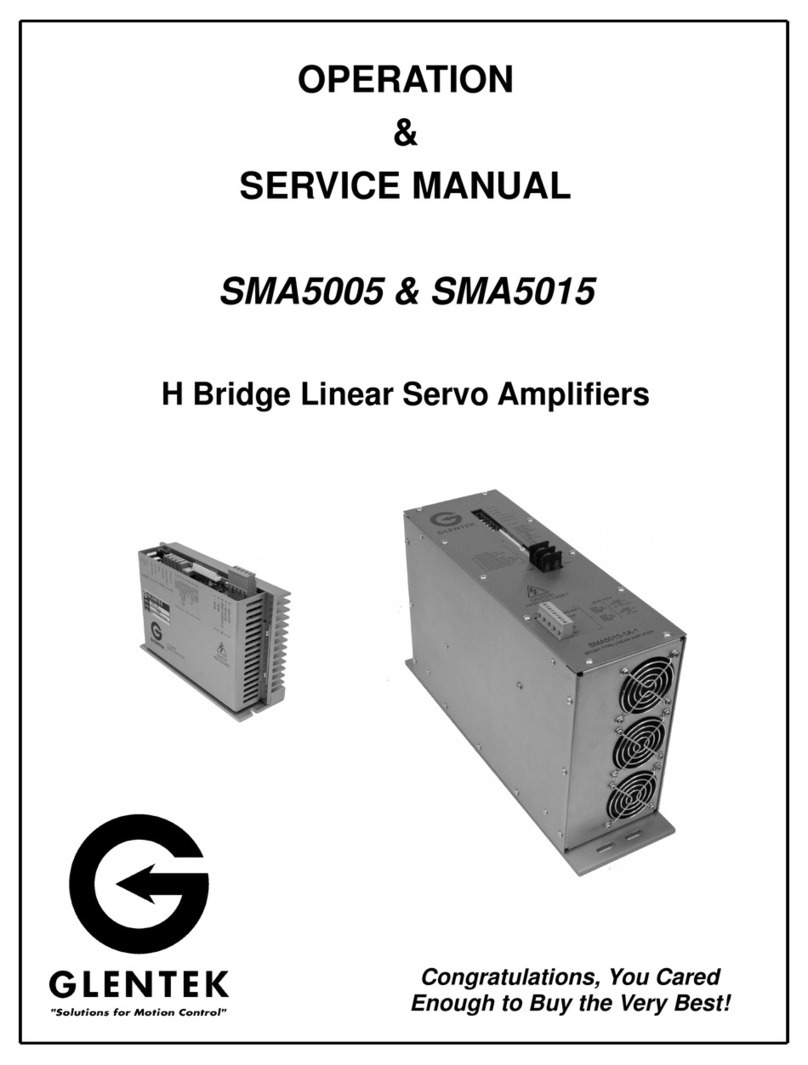
Glentek
Glentek SMA5005 Installation and operating instructions
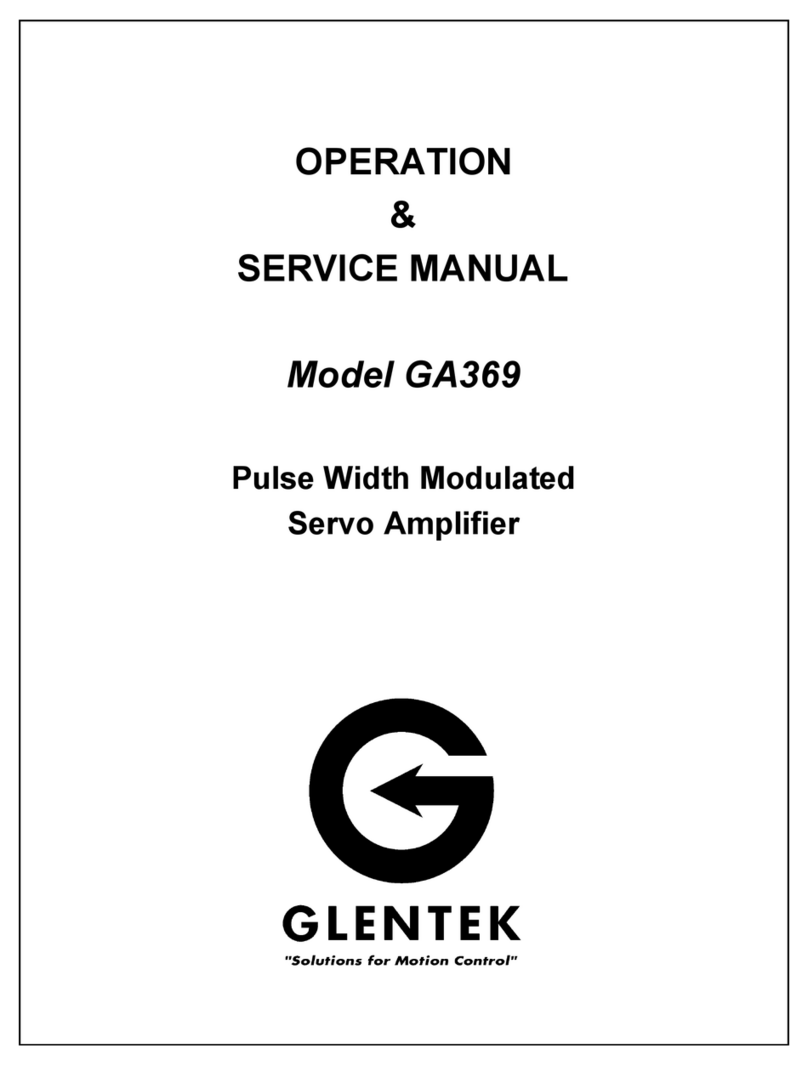
Glentek
Glentek GA369 Installation and operating instructions
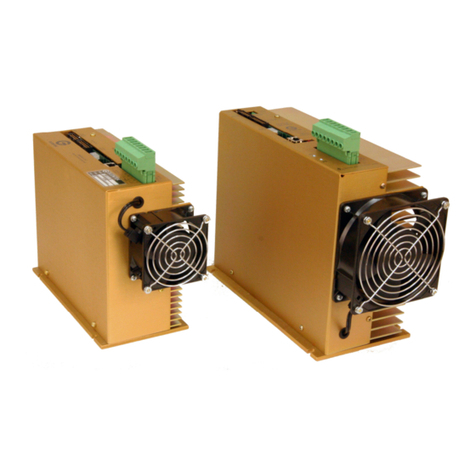
Glentek
Glentek Alpha Series User manual

Glentek
Glentek Alpha Series User manual
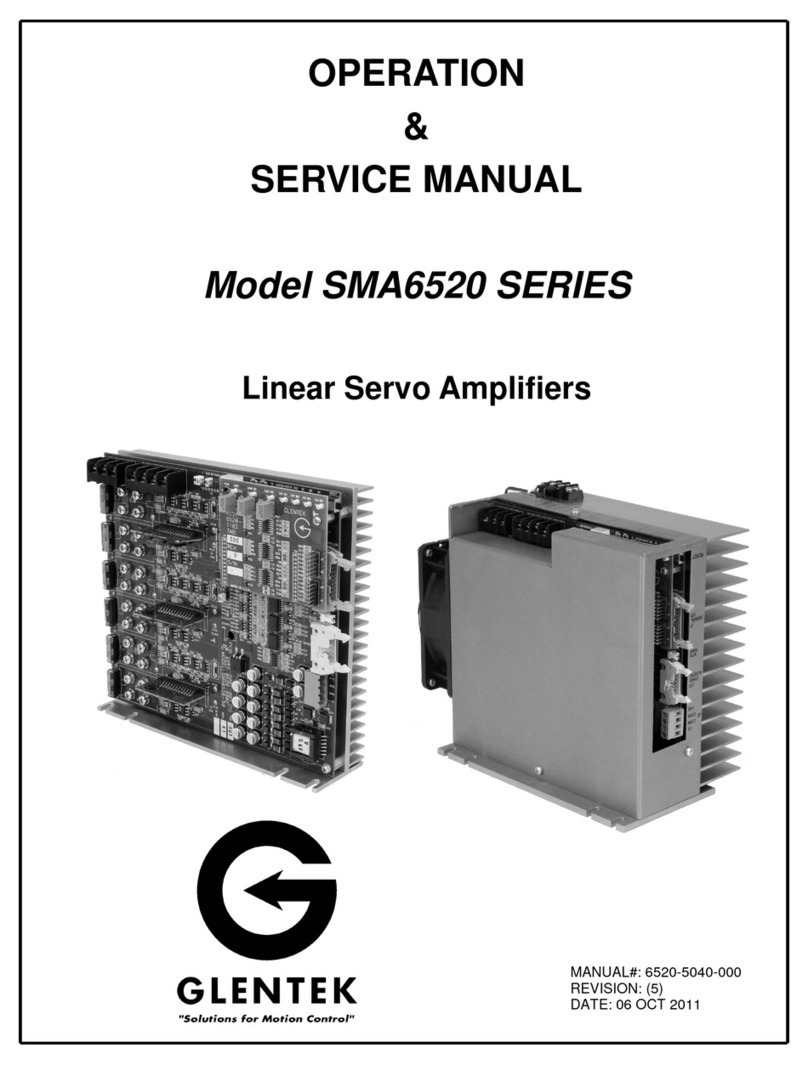
Glentek
Glentek SMA6520 SERIES Installation and operating instructions
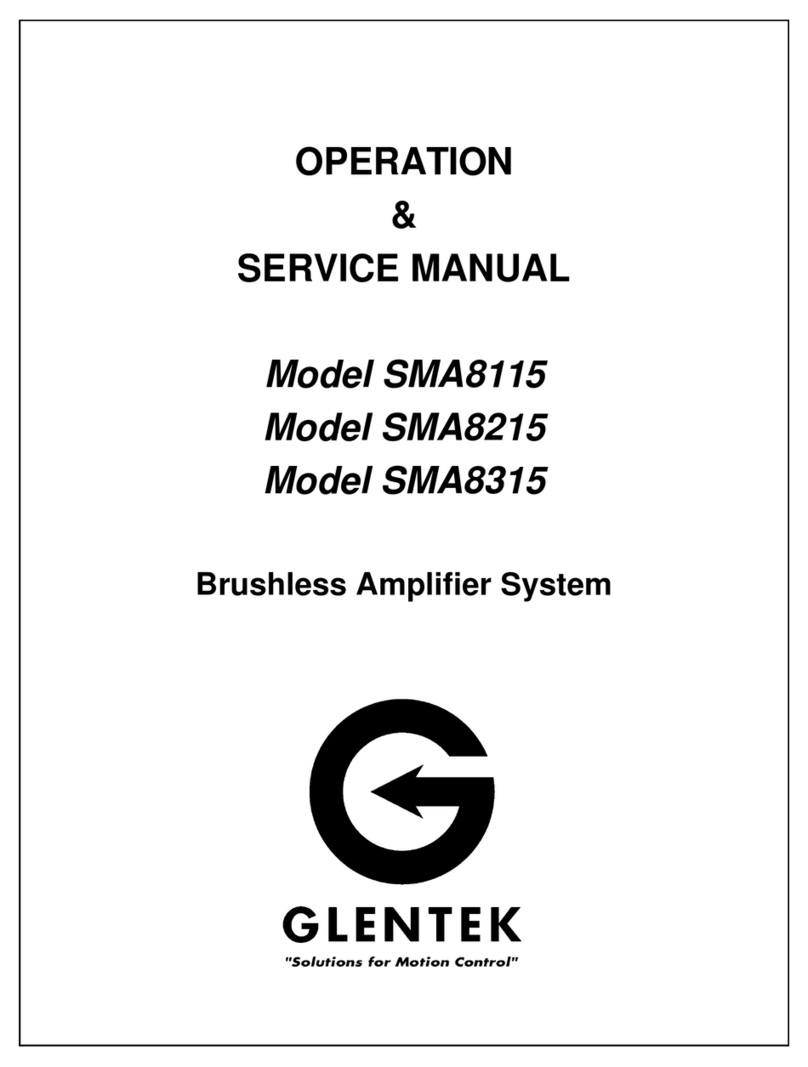
Glentek
Glentek SMA8115 Installation and operating instructions
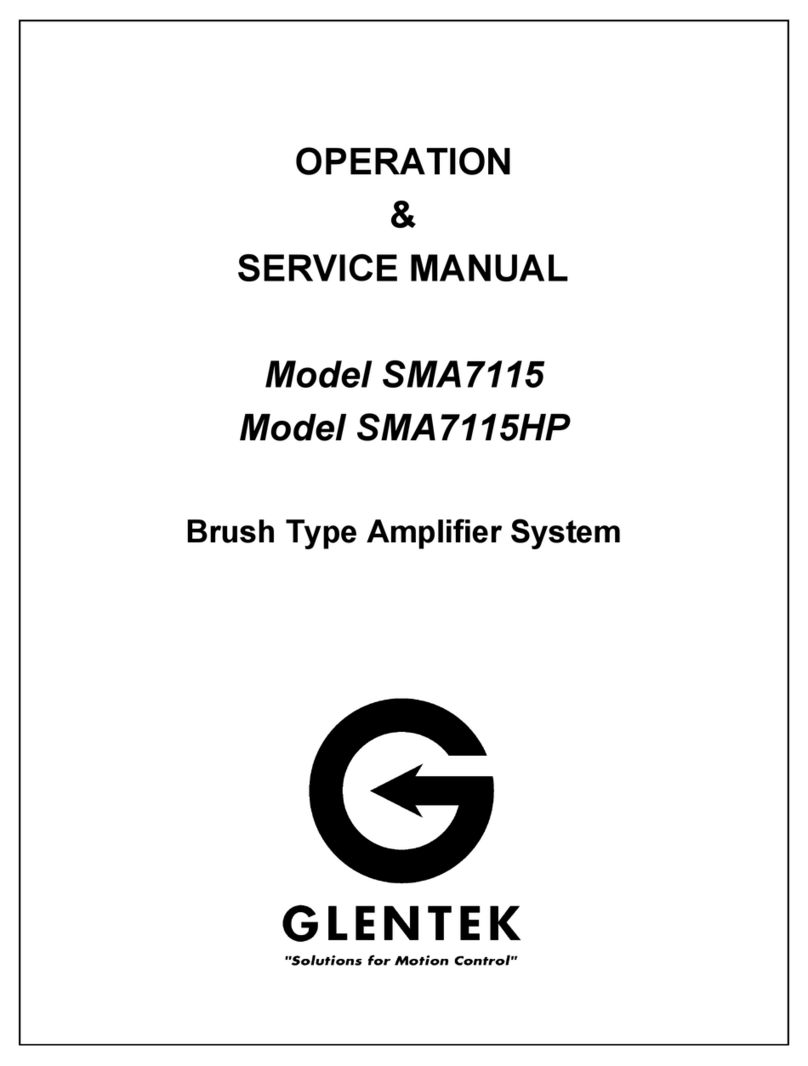
Glentek
Glentek SMA7115HP Installation and operating instructions
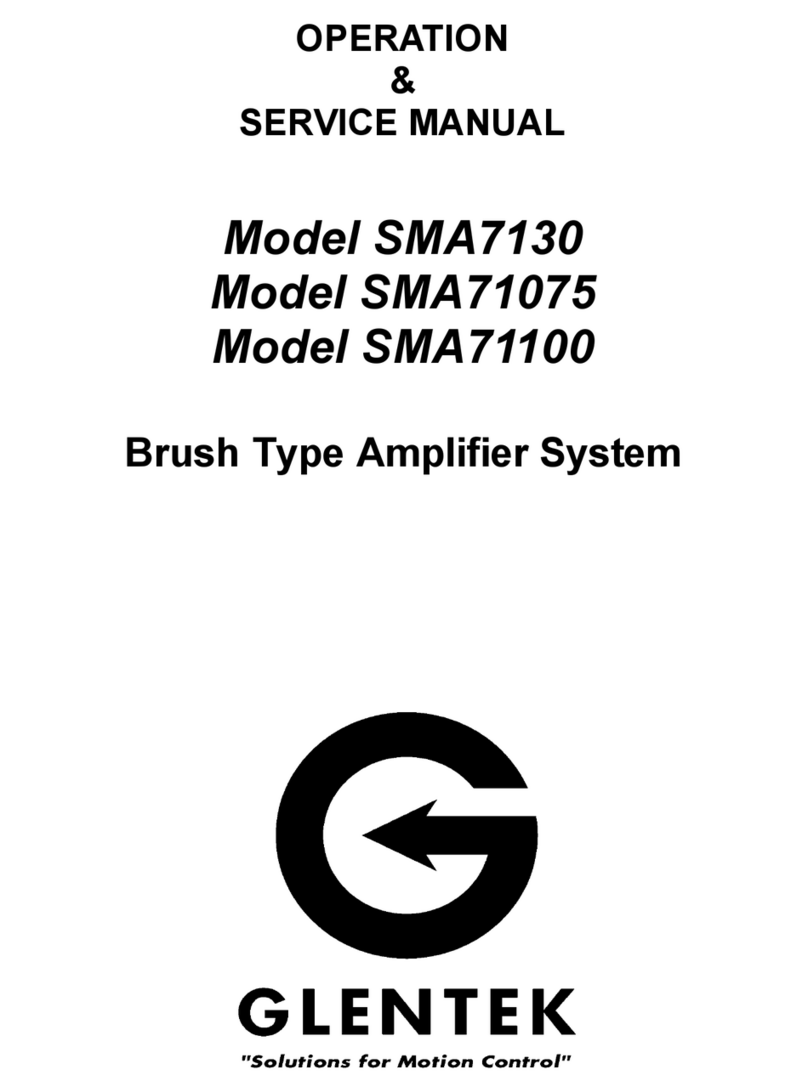
Glentek
Glentek SMA7130 Installation and operating instructions

Glentek
Glentek Omega Series User manual
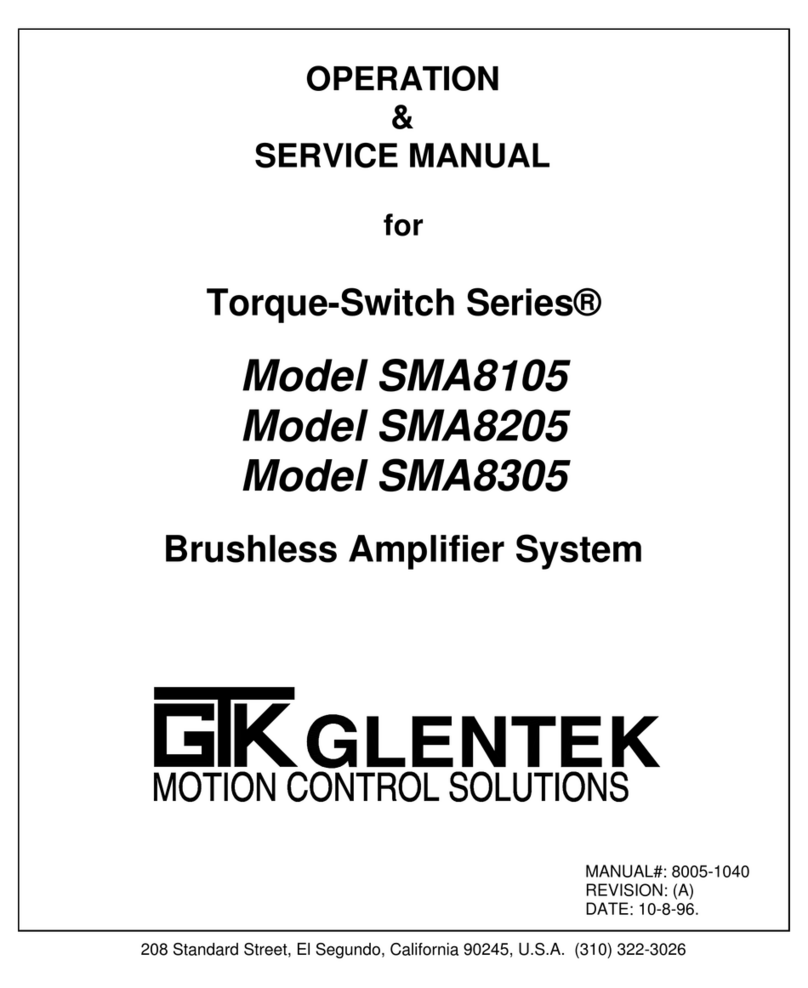
Glentek
Glentek SMA8105 Installation and operating instructions



